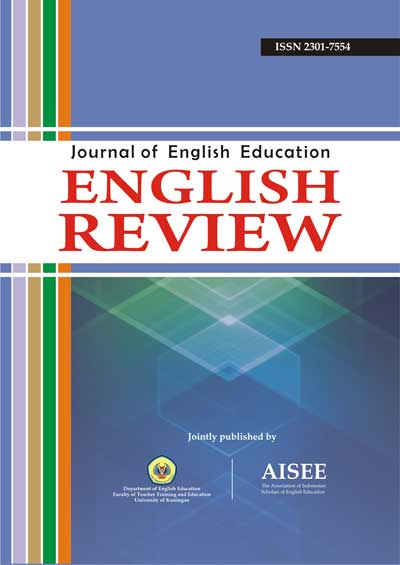INVESTIGATING CHINESE EFL STUDENTS’ PERCEPTIONS OF WRITING PROMPTS OF DIFFERENT AMOUNTS OF INFORMATION
Abstract
Abstract: This study aims to explore how Chinese EFL students perceive the advantages and disadvantages of prompts providing different amount of information, namely prompt with more information and prompt with less information. Both qualitative and quantitative data were collected through questionnaire survey and semi-structured interview. Research results indicate that: 1) Respondents hold a mixed attitude towards the prompt effect on their task accomplishment. 2) Students believe that prompt type can affect their expression in writing; 3) Students generally agree that prompt with more information facilitate their writing in terms of content and organization; 4) Students’ preference for the prompt type differs across different English proficiency level.
Keywords: prompt effect, English writing, testing writing, perceptions
References
Alderson, J. C., Clapham, C., & Wall, D. (2000). Language test construction and evaluation. Beijing: Foreign Language Teaching and Research Press.
Bachman, L., & Palmer, A. (1996). Language testing in practice. Oxford: Oxford University Press.
Brossell, G. (1983). Rhetorical specification in essay examination topics. College English, 45(2), 165-173
Brossell, G., & Ash, B. H. (1984). An experiment with the wording of essay topics. College Composition and Communication, 35(4), 423-425
Chiste, K. B., & O'Shea, J. (1988). Patterns of question selection and writing performance of ESL students. Teachers of English to Speakers of Other Languages, 22(4).
Gu, X., & Gao, X. (2007). An investigation into the writing tasks of NMET 2007. China Examinations, (12), 28-36.
Gu, X., Yang, R., & Feng, N. (2010). A study on the quality of the writing tasks of NMET. Educational Measurement and Evaluation , (12), 47-50.
Hinkel, E. (2002). Second language writer’s text: Linguistic and rhetorical features. Mahwah, NJ: Lawrence Erlbaum.
Jennings, M., Fox, J., & Graves, B. (1999). The test-takers' choice: an investigation of the effect of topic on language-test performance. Language Testing (16), 456-462
Kroll, B., & Reid, J. (1994). Guidelines for designing writing prompts: clarifications, caveats and cautions. Journal of Second Language Writing. 3(3), 231-255.
Li, X. (2001). The science and art of language testing. Changsha: Hunan Education Press.
Ministry of Education. (2001). National English curriculum standards. Beijing: Beijing Normal University Press.
Messick, S. (1996). The interplay of evidence and consequences in the validation of performance assessments. Educational Researcher, 23(2), 13-23.
Oh, H., & Walker, M. E. (2007). The effects of essay placement and prompt type on performance on the new SAT. New York: The College Board.
O’Loughlin, K., & Wigglesworth, G. (2007). Investigating task design in academic writing prompts. In Taylor, L. (Ed.), IELTS collected papers: research in speaking and writing assessment. 379-418. Cambridge: Cambridge University Press.
Polio, C., & Glew, M. (1996). ESL writing assessment prompts: How students choose. Journal of Second Language Writing, 5(1), 35-49
Powers, D. E., & Fowles, M. E. (1998). Test takers' judgment about GRE writing test prompts (RR 98-36). NJ: Princeton: ETS.
Qi, L., (2004). A study on the washback of NMET. Foreign Language Teaching and Research, 36(5), 357-363.
Weigle, S. C. (2011). Assessing writing. Beijing: Foreign Language Teaching and Research Press.
Wu,Z. (2008). Theory and practice of English language testing. Beijing: Foreign Language Teaching and Research Press.
All articles published in English Review: Journal of English Education (ERJEE) are licensed under the Creative Commons Attribution 4.0 International License (CC BY 4.0).
Copyright Ownership
Authors retain the copyright of their articles and grant ERJEE the right of first publication. The journal is granted a non-exclusive license to publish, reproduce, and distribute the article in any format, medium, or platform, provided that proper credit is given to the original authors.
License Terms – CC BY 4.0
Under the Creative Commons Attribution 4.0 International License, others are free to:
- Share — copy and redistribute the material in any medium or format
- Adapt — remix, transform, and build upon the material for any purpose, even commercially
As long as they:
- Provide appropriate credit to the original author(s) and source
- Provide a link to the license (https://creativecommons.org/licenses/by/4.0/)
- Indicate if any changes were made
There are no restrictions on the reuse, reproduction, or adaptation of published articles as long as attribution is properly given.
Author Warranties
By submitting a manuscript to ERJEE, authors confirm that:
- The work is original and does not infringe any existing copyright.
- The manuscript has not been previously published and is not under consideration elsewhere.
- All sources and references are appropriately acknowledged.
- Necessary permissions have been obtained for any copyrighted materials used.










